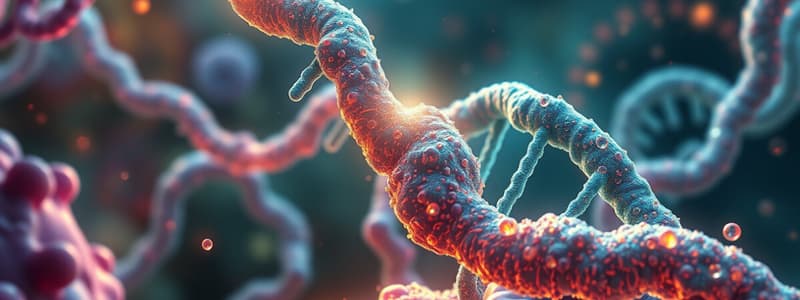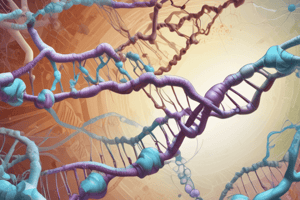Podcast
Questions and Answers
List 5 types of post-translational modifications.
List 5 types of post-translational modifications.
- Amino acid removal from the end of the polypeptide chain 2. Chain enzymatically cleaved into pieces 3. Cut out central & reattach other parts (insulin) 4. Attach two or more separate polypeptides (hemoglobin) 5. Add sugars, phosphates, lipids, etc.
Define a mutation in terms of molecular genetics.
Define a mutation in terms of molecular genetics.
Changes to the genetic information of a cell or virus.
Define point mutations.
Define point mutations.
Chemical changes in a single base pair of a gene.
What are frameshift mutations?
What are frameshift mutations?
Explain how proteins are targeted for the ER (6 steps).
Explain how proteins are targeted for the ER (6 steps).
Where does polypeptide synthesis take place?
Where does polypeptide synthesis take place?
What is the difference between a nonsense and missense mutation?
What is the difference between a nonsense and missense mutation?
Identify two mechanisms by which frameshifts may occur.
Identify two mechanisms by which frameshifts may occur.
How can a base pair substitution result in a silent mutation?
How can a base pair substitution result in a silent mutation?
What are the two categories of mutagens?
What are the two categories of mutagens?
Describe 2 important ways in which bacterial and eukaryotic genes differ.
Describe 2 important ways in which bacterial and eukaryotic genes differ.
What is a gene? Write a more accurate version of 'one gene codes for one polypeptide.'
What is a gene? Write a more accurate version of 'one gene codes for one polypeptide.'
Summarize 'From Gene to Protein' (6 steps).
Summarize 'From Gene to Protein' (6 steps).
What is gene expression?
What is gene expression?
What situation did Archibald Garrod suggest caused inborn errors of metabolism?
What situation did Archibald Garrod suggest caused inborn errors of metabolism?
Describe one example Garrod used to illustrate his hypothesis.
Describe one example Garrod used to illustrate his hypothesis.
State the hypothesis formulated by George Beadle while studying eye color mutations in Drosophila.
State the hypothesis formulated by George Beadle while studying eye color mutations in Drosophila.
What strategy did Beadle and Tatum adopt to test George Beadle's hypothesis about eye color mutations in Drosophila?
What strategy did Beadle and Tatum adopt to test George Beadle's hypothesis about eye color mutations in Drosophila?
How did Beadle and Tatum figure out what mutant was defective in what area?
How did Beadle and Tatum figure out what mutant was defective in what area?
Cite two significant findings that resulted from the research of Beadle and Tatum.
Cite two significant findings that resulted from the research of Beadle and Tatum.
What is the hypothesis of gene expression?
What is the hypothesis of gene expression?
What are three ways that RNA differs from DNA?
What are three ways that RNA differs from DNA?
What are the monomers of DNA, RNA, or proteins?
What are the monomers of DNA, RNA, or proteins?
Define the process of transcription.
Define the process of transcription.
Define the process of translation.
Define the process of translation.
Where does translation occur in a eukaryotic cell?
Where does translation occur in a eukaryotic cell?
In eukaryotes, what is the pre-mRNA called?
In eukaryotes, what is the pre-mRNA called?
Write the central dogma of molecular genetics, as proclaimed by Francis Crick.
Write the central dogma of molecular genetics, as proclaimed by Francis Crick.
How many nucleotide bases are there? How many amino acids?
How many nucleotide bases are there? How many amino acids?
How many nucleotides are required to code for these 20 amino acids?
How many nucleotides are required to code for these 20 amino acids?
How many codons are there?
How many codons are there?
DNA is double stranded, but for each protein, only one of these two strands is used to produce an mRNA transcript. What is the coding strand called?
DNA is double stranded, but for each protein, only one of these two strands is used to produce an mRNA transcript. What is the coding strand called?
What are codons?
What are codons?
Describe Nirenberg's experiment in which he identified the first codon.
Describe Nirenberg's experiment in which he identified the first codon.
What was the first codon-amino acid pair to be identified?
What was the first codon-amino acid pair to be identified?
Of the 64 possible codons, how many code for amino acids, and what are the rest?
Of the 64 possible codons, how many code for amino acids, and what are the rest?
What is the start codon?
What is the start codon?
Why is the genetic code said to be redundant but not ambiguous?
Why is the genetic code said to be redundant but not ambiguous?
Explain the concept of reading frame.
Explain the concept of reading frame.
Name the enzyme that uses the DNA template strand to transcribe a new mRNA strand.
Name the enzyme that uses the DNA template strand to transcribe a new mRNA strand.
Both DNA polymerase III and RNA polymerase can assemble a new polynucleotide only in the 5' -> 3' direction. Which enzyme, DNA pol III or RNA pol, doesn't need a primer to begin synthesis?
Both DNA polymerase III and RNA polymerase can assemble a new polynucleotide only in the 5' -> 3' direction. Which enzyme, DNA pol III or RNA pol, doesn't need a primer to begin synthesis?
What is a transcription unit?
What is a transcription unit?
What are the 3 stages of transcription?
What are the 3 stages of transcription?
How many RNA polymerases do bacteria and eukaryotes have?
How many RNA polymerases do bacteria and eukaryotes have?
List 3 important facts about the promoter.
List 3 important facts about the promoter.
What are the 3 stages of initiation?
What are the 3 stages of initiation?
What is the TATA box?
What is the TATA box?
What comprises a transcription initiation complex?
What comprises a transcription initiation complex?
RNA processing happens only in ______ cells. What is it in one sentence?
RNA processing happens only in ______ cells. What is it in one sentence?
What happens at the 5' end of the primary transcript in RNA processing?
What happens at the 5' end of the primary transcript in RNA processing?
What happens at the 3' end of the primary transcript in RNA processing?
What happens at the 3' end of the primary transcript in RNA processing?
What are 3 important functions of the 5' cap and the poly-A tail?
What are 3 important functions of the 5' cap and the poly-A tail?
What are UTRs?
What are UTRs?
Distinguish between introns and exons.
Distinguish between introns and exons.
Explain eukaryotic termination.
Explain eukaryotic termination.
What are snRNPs and what two types of molecules make up snRNPs?
What are snRNPs and what two types of molecules make up snRNPs?
What type of RNA is in a snRNP?
What type of RNA is in a snRNP?
How do spliceosomes work?
How do spliceosomes work?
List the 3 steps of modifying a pre-mRNA.
List the 3 steps of modifying a pre-mRNA.
Explain how splice sites are recognized.
Explain how splice sites are recognized.
What are ribozymes?
What are ribozymes?
What commonly held idea was rendered obsolete by the discovery of ribozymes?
What commonly held idea was rendered obsolete by the discovery of ribozymes?
What are the 3 properties of RNA that allow it to function as an enzyme?
What are the 3 properties of RNA that allow it to function as an enzyme?
What is the consequence of alternative splicing of identical mRNA transcripts?
What is the consequence of alternative splicing of identical mRNA transcripts?
What is an anticodon?
What is an anticodon?
Describe the structure and function of mRNA.
Describe the structure and function of mRNA.
Describe the structure and function of tRNA.
Describe the structure and function of tRNA.
Describe the structure and function of rRNA.
Describe the structure and function of rRNA.
What is exon shuffling?
What is exon shuffling?
Where is tRNA made and what are the bonds it makes?
Where is tRNA made and what are the bonds it makes?
How many different aminoacyl-tRNA synthetases are there, and what are they?
How many different aminoacyl-tRNA synthetases are there, and what are they?
What is wobble?
What is wobble?
Explain the process of a specific amino acid being joined to a tRNA.
Explain the process of a specific amino acid being joined to a tRNA.
Describe the structure of a eukaryotic ribosome and how it's made.
Describe the structure of a eukaryotic ribosome and how it's made.
How does a prokaryotic ribosome differ from a eukaryotic ribosome? What is the medical significance of this difference?
How does a prokaryotic ribosome differ from a eukaryotic ribosome? What is the medical significance of this difference?
Explain the functions of the APE sites.
Explain the functions of the APE sites.
What are the 3 stages of translation?
What are the 3 stages of translation?
Summary of initiation:
Summary of initiation:
Is a ribosome an enzyme?
Is a ribosome an enzyme?
Summary of elongation:
Summary of elongation:
What is a release factor? By what mechanism is termination accomplished?
What is a release factor? By what mechanism is termination accomplished?
What is a polyribosome?
What is a polyribosome?
What are some of the things that will result in a final-form functional protein?
What are some of the things that will result in a final-form functional protein?
Flashcards are hidden until you start studying
Study Notes
Gene Expression and Its Mechanisms
- Gene expression refers to the process by which DNA instructs the synthesis of proteins and sometimes RNA.
- Archibald Garrod proposed the concept of inborn errors of metabolism, indicating that some individuals cannot produce specific enzymes necessary for metabolism.
- Alkaptonuria exemplifies Garrod's hypothesis; individuals with this condition cannot metabolize alkapton, resulting in black urine due to its accumulation.
Research by Beadle and Tatum
- George Beadle hypothesized that mutations affecting eye color in Drosophila hinder pigment synthesis by blocking specific enzymatic production.
- Beadle and Tatum utilized the fungus Neurospora to test their hypothesis, finding that mutants unable to survive on minimal media lacked necessary enzymes for specific nutrient synthesis.
- Their research confirmed that genes dictate specific enzyme production and highlighted the fact that not all proteins are enzymes.
Transcription and Translation Processes
- One gene corresponds to one polypeptide; however, eukaryotic genes can code for multiple related proteins through alternative splicing.
- RNA differs from DNA in three ways: it contains ribose instead of deoxyribose, uses uracil instead of thymine, and is typically single-stranded.
- Transcription involves using DNA as a template to produce a complementary mRNA strand, while translation is the synthesis of a polypeptide directed by mRNA.
- In eukaryotic cells, translation takes place in the cytoplasm, with pre-mRNA referred to as a primary transcript before modifications occur.
Genetic Coding and Codons
- The central dogma of molecular genetics presents the flow of genetic information as DNA → RNA → Protein.
- There are 64 codons used to code for 20 amino acids, with UAA, UAG, and UGA serving as stop codons.
- The start codon is AUG, coding for methionine.
RNA Processing and Splicing
- Eukaryotic RNA processing involves modifications to the primary transcript, including the addition of a 5' cap and a poly-A tail, which protect mRNA and facilitate its export.
- Introns are non-coding segments, while exons are the coding regions that exit the nucleus.
- Spliceosomes, formed from small nuclear ribonucleoproteins (snRNPs), splice out introns and join exons together.
Ribosomes and Protein Synthesis
- Ribosomes consist of rRNA and proteins, with distinct sites for aminoacyl-tRNA (A site), peptide chains (P site), and ejected tRNAs (E site).
- The translation process includes three stages: initiation (bringing mRNA and tRNA together), elongation (adding amino acids to the growing chain), and termination (recognizing stop codons).
- Release factors bind to stop codons during termination, releasing the completed polypeptide.
Post-Translational Modifications
- Proteins may undergo post-translational modifications like amino acid removal, cleavage, or addition of functional groups to achieve their active forms.
- Alternative splicing allows a single gene to code for multiple proteins by varying the exon combinations in mRNA.
Mutations and Genetic Variability
- Mutations are alterations in genetic information, leading to genetic diversity among organisms.
- Point mutations involve changes to individual base pairs, while frameshift mutations occur from insertions or deletions, shifting the reading frame and altering subsequent amino acids.
Targeting Proteins to the Endoplasmic Reticulum (ER)
- Polypeptide synthesis is initiated on free ribosomes in the cytosol until a signal peptide is recognized by a signal recognition particle (SRP).
- The SRP guides the ribosome to the ER, where synthesis resumes and the signal peptide is cleaved upon entry into the ER, allowing for further processing.### Mutations
- Nonsense mutations lead to premature termination of protein translation, generally resulting in non-functional proteins.
- Missense mutations modify a single amino acid in the protein sequence, potentially altering protein function.
Frameshift Mechanisms
- Frameshifts occur through insertion or deletion of nucleotides that are not multiples of three, disrupting normal codon grouping.
- The impact of frameshifts is that all downstream codons are misread, causing extensive sequence changes.
Silent Mutations
- Base pair substitutions, like the change from CCG to CCA, can result in silent mutations where the same amino acid is still produced, leaving the organism unaffected.
Mutagens
- Two categories of mutagens affecting DNA are physical and chemical agents.
- Physical mutagens, such as X-rays, induce mutations by damaging DNA.
- Chemical mutagens include:
- Base analogs that mispair during DNA replication.
- Insertions that physically distort the DNA double helix.
- Agents causing chemical changes that alter base pairing properties.
Gene Differences in Bacteria and Eukaryotes
- Bacterial and eukaryotic gene expression differs mainly in translation initiation and termination processes.
- Bacteria, lacking compartmentalization, can simultaneously transcribe and translate mRNA.
Definition of a Gene
- A gene is a DNA segment that encodes a functional product, which may be RNA or a polypeptide.
From Gene to Protein Overview
- Transcription of RNA from DNA occurs first.
- In eukaryotes, pre-mRNA is spliced and modified to form mRNA, which exits the nucleus to the cytoplasm.
- mRNA attaches to ribosomes for translation.
- tRNA brings appropriate amino acids to the ribosome with ATP assistance.
- Amino acids are sequentially added to the growing polypeptide chain as mRNA codons are read.
- The completed polypeptide is released for further modification or is finalized as a functional protein.
Studying That Suits You
Use AI to generate personalized quizzes and flashcards to suit your learning preferences.



